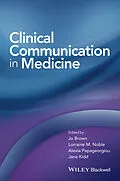Highly Commended at the British Medical Association Book Awards 2016Clinical Communication in Medicine brings together the theories, models and evidence that underpin effective healthcare communication in one accessible volume. Endorsed and developed by members of the UK Council of Clinical Communication in Undergraduate Medical Education, it traces the subject to its primary disciplinary origins, looking at how it is practised, taught and learned today, as well as considering future directions.Focusing on three key areas the doctor-patient relationship, core components of clinical communication, and effective teaching and assessment Clinical Communication in Medicine enhances the understanding of effective communication. It links theory to teaching, so principles and practice are clearly understood.Clinical Communication in Medicine is a new and definitive guide for professionals involved in the education of medical undergraduate students and postgraduate trainees, as well as experienced and junior clinicians, researchers, teachers, students, and policy makers.
Autorentext
Dr Jo Brown, Reader in Medical Education, Academic Director of the Student Experience, Head of Clinical Communication, National Teaching Fellow, St George's, University of London.
Dr Lorraine M Noble, Senior Lecturer in Clinical Communication, UCL Medical School, UCL, London, UK.
Dr Alexia Papageorgiou, Associate Professor in Clinical Communication, St George's, University of London medical programme, delivered in Cyprus by the University of Nicosia Medical School.
Dr Jane Kidd, Undergraduate Quality Manager, Education Training and Research, University Hospitals Coventry and Warwickshire NHS Trust; External tutor, Institute of Medical and Biomedical Education, St George's University of London.
Zusammenfassung
Highly Commended at the British Medical Association Book Awards 2016
Clinical Communication in Medicine brings together the theories, models and evidence that underpin effective healthcare communication in one accessible volume. Endorsed and developed by members of the UK Council of Clinical Communication in Undergraduate Medical Education, it traces the subject to its primary disciplinary origins, looking at how it is practised, taught and learned today, as well as considering future directions.
Focusing on three key areas the doctor-patient relationship, core components of clinical communication, and effective teaching and assessment Clinical Communication in Medicine enhances the understanding of effective communication. It links theory to teaching, so principles and practice are clearly understood.
Clinical Communication in Medicine is a new and definitive guide for professionals involved in the education of medical undergraduate students and postgraduate trainees, as well as experienced and junior clinicians, researchers, teachers, students, and policy makers.
Inhalt
Contributors viii
Foreword xi
1 Introduction 1 Jane Kidd
Part 1: The doctor-patient relationship Section lead editor: Lorraine M. Noble
2 Introduction to the Doctor-Patient Relationship 5 Lorraine M. Noble
3 History of the Doctor-Patient Relationship 6 Annie Cushing
4 Models of the Doctor-Patient Consultation 21 Alexia Papageorgiou
5 What Is Effective Doctor-Patient Communication? Review of the Evidence 30 Gregory Makoul and Sandra van Dulmen
6 Patient-Centredness 40 Rosie Illingworth
7 The Impact of Training 49 John Skelton
8 The Future of the Doctor-Patient Relationship 57 Lorraine M. Noble
Part 2: Components of Communication Section lead editor: Alexia Papageorgiou
Part 2A: Core Tasks in Clinical Communication
9 Overview of Core Tasks in Clinical Communication 69 Jonathan Silverman
10 Relationship Building 72 Jonathan Silverman
11 Information Gathering and Clinical Reasoning 76 Jonathan Silverman
12 Information Sharing and Shared Decision Making 81 Jonathan Silverman Copyrighted Material
13 Communicating about Risk and Uncertainty 87 Katherine Joekes
14 Responding to Emotions 91 Theano V. Kalavana
15 Breaking Bad News 98 Rob Lane
16 Facilitating Behaviour Change through Motivational Interviewing 104 Eva Doherty
17 Responding to Medical Error and Complaints 108 Lucy Ambrose and Lindsey Pope
Part 2B: Diversity Issues in Clinical Communication and Cultural Diversity
18 Overview of Diversity Issues in Clinical Communication 117 Costas S. Constantinou
19 Diversity Issues in Clinical Communication 119 Margot Turner and Nisha Dogra
20 The Family Consultation 127 Xavier Coll
21 Consulting with Children and Young People 131 Xavier Coll
22 The Older Patient 138 Andrew Tarbuck
23 End of Life Issues 147 Vinnie Nambisan and Jennifer Balls
24 Mental Health Matters 151 Jonathan Wilson
Part 2C: Interprofessional Communication
25 Interprofessional Communication and Its Challenges 159 Susanne Lindqvist
Part 3: Learning Teaching and Assessment Section lead editor: Jo Brown
26 Introduction to Learning Teaching and Assessment 171 Jo Brown
27 The History of Clinical Communication Teaching 172 Victoria Bates Jonathan Reinarz and Connie Wiskin
Part 3A: Models of Learning
28 Behaviourism as a Way of Learning 181 Jo Brown
29 Situated and Work-Based Learning 186 Jo Brown
30 Experiential Learning 193 Jan van Dalen
31 Transformative Learning and High-Fidelity Simulation 200 Wesley Scott-Smith
32 Reflective Practice 206 Sally Quilligan
33 Models of Feedback 211 Catherine J. Williamson Jill Dales and John Spencer
Part 3B: The Assessment of Communication
34 Introduction to Assessment in Communication 221 Jane Kidd
35 Assessing Performance 233 Connie Wiskin and Janet Lefroy
36 Workplace-Based Assessment 241 Jane Kidd and Janet Lefroy
Part 4: Afterword
37 Afterword 251 Jo Brown Lorraine M. Noble Alexia Papageorgiou and Jane Kidd
Index 252
